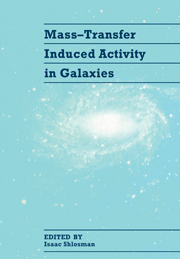Book contents
- Frontmatter
- Contents
- Preface
- List of Participants
- I INTRODUCTION
- II THE INNER PARSEC
- III THE CIRCUMNUCLEAR REGION
- IV GAS DYNAMICS AND STAR FORMATION IN BARRED AND NORMAL GALAXIES
- V NUCLEAR GAS AND LARGE-SCALE PROPERTIES OF AGN AND STARBURST HOSTS
- VI HOST GALAXY-AGN-NUCLEAR STARBURST CONNECTION
- VII GALAXY INTERACTIONS AND INDUCED ACTIVITY
- VIII GAS DYNAMICS IN ELLIPTICALS
- IX AGN AND STARBURST HOSTS AT LARGE REDSHIFTS
- Early AGN and Galaxy Formation (Invited paper)
- Collapses, Collisions, Quasars, and Cosmogony (Invited paper)
- The Evolution of Quasar Host Galaxies
- Evolution of the Galaxy Merger Rate: Counting Pairs in HST Fields (Poster paper)
- Stellar Mass Loss in Ellipticals and the Fueling of AGN (Poster paper)
- Star–Forming Galaxies and Large–Scale Structure (Poster paper)
- X CONFERENCE SUMMARY
- Subject Index
- Object Index
- Author Index
The Evolution of Quasar Host Galaxies
Published online by Cambridge University Press: 05 May 2010
- Frontmatter
- Contents
- Preface
- List of Participants
- I INTRODUCTION
- II THE INNER PARSEC
- III THE CIRCUMNUCLEAR REGION
- IV GAS DYNAMICS AND STAR FORMATION IN BARRED AND NORMAL GALAXIES
- V NUCLEAR GAS AND LARGE-SCALE PROPERTIES OF AGN AND STARBURST HOSTS
- VI HOST GALAXY-AGN-NUCLEAR STARBURST CONNECTION
- VII GALAXY INTERACTIONS AND INDUCED ACTIVITY
- VIII GAS DYNAMICS IN ELLIPTICALS
- IX AGN AND STARBURST HOSTS AT LARGE REDSHIFTS
- Early AGN and Galaxy Formation (Invited paper)
- Collapses, Collisions, Quasars, and Cosmogony (Invited paper)
- The Evolution of Quasar Host Galaxies
- Evolution of the Galaxy Merger Rate: Counting Pairs in HST Fields (Poster paper)
- Stellar Mass Loss in Ellipticals and the Fueling of AGN (Poster paper)
- Star–Forming Galaxies and Large–Scale Structure (Poster paper)
- X CONFERENCE SUMMARY
- Subject Index
- Object Index
- Author Index
Summary
ABSTRACT
Analysis of quasar broad emission lines suggests that the emitting gas is substantially enriched, often well above solar at high redshifts. The abundances are like those expected in the cores of massive galaxies early in their evolution, suggesting that observable quasars occur near the end of the epoch when rapid star formation, dominated by high mass stars, has created an enriched interstellar medium. An increase in the derived metallicities with both redshift and luminosity suggests that there is a mass-metallicity relation among quasars analogous (or identical) to the mass-metallicity relation in elliptical galaxies. This relation is consistent with the most massive quasars and/or host galaxies forming only at high redshifts.
INTRODUCTION
Observations of strong metallic emission lines in quasars out to redshift ∼4.9 imply some enrichment at times when the Universe was less than 10% of its present age. If quasars reside in the cores of massive galaxies, their gaseous environments could easily have larger than solar abundances, even at the highest redshifts. Observations and models of giant elliptical galaxies show that metallicities of at least several Z⊙ are attained in less than 1 Gyr (cf. Arimoto and Yoshii 1987). In the bulge of our own galaxy the stellar metallicities also reach at least a few Z⊙ (Rich 1988) and the enrichment is again believed to occur in ≲ Gyr (Köppen and Arimoto 1990). Since the gas in any evolving star cluster is as chemically enriched as the most recently formed stars, and thus more enriched than the bulk of the stellar population, metallicities above solar may be typical of the gas in massive galactic nuclei.
- Type
- Chapter
- Information
- Mass-Transfer Induced Activity in Galaxies , pp. 478 - 482Publisher: Cambridge University PressPrint publication year: 1994

